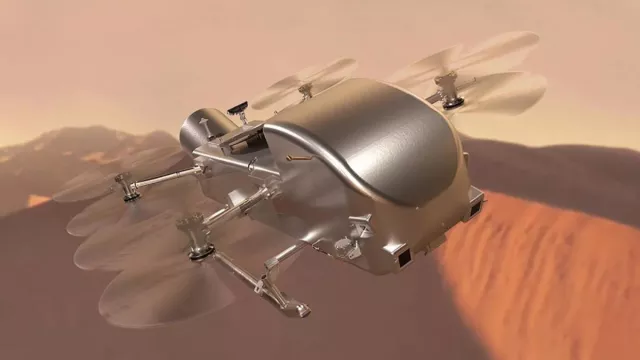Dragonfly is a rotorcraft mission designed to explore the surface of Titan, Saturn’s largest moon.
Key information
Key figures
- 850 kg: mass of octocopter
- 4 km: maximum altitude
- 175 km covered
- 36 km/h: speed of rotorcraft
Key milestones
- 2034: Arrival on Titan
- 2028: Launch of DragonFly by Falcon Heavy (to be confirmed)
- 14 March 2022: NASA and CNES sign cooperation agreement for DragonFly mission
- 27 June 2019: DragonFly mission selected by NASA
- 14 January 2005: Huygens probe lands on Titan
Project in brief
The Dragonfly mission is setting out to explore a carbon-rich atmosphere. It will be the second instrumented rotorcraft to fly on another body in the solar system other than Earth, after the demonstration flights of Ingenuity for the Perseverance mission on Mars. The octocopter will have four double rotors, a radioisotope thermoelectric generator (RTG) and scientific instruments to study Titan’s surface and atmosphere over several hundred kilometres. It will have much greater range and autonomy (up to 8 km) than Ingenuity, and be able to fly at a much higher altitude (up to 4 km). The mission’s goal is to study Titan’s biochemistry to find out if past or extant life could have developed there in conditions different to those on Earth.
Dragonfly was selected in 2019 as the fourth mission of NASA’s New Frontiers programme. It is currently scheduled for launch in June 2028 to land on Titan end 2034.
CNES’s role
CNES is heading the French contribution to the mission, which covers:
- DraMS (Dragonfly Mass Spectrometer), for which the LGPM and LESIA research laboratories are designing and building the DraMS-GC (Gas Chromatography) subsystem for prime contractor the LATMOS research laboratory.
- DraGMet (Dragonfly Geophysics and Meteorology Package), with a scientific contribution.
Contacts
Project Leader for French contribution to Dragonfly
Gabriel Pont
E-mail: gabriel.pont at cnes.fr
Exobiology, Exoplanets and Planetary Protection subject matter expert
Christian Mustin
E-mail: christian.mustin at cnes.fr


